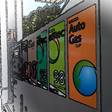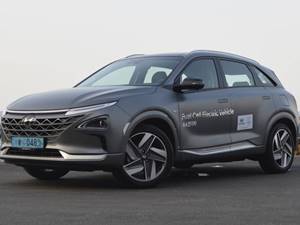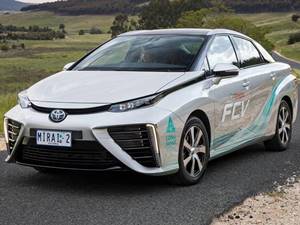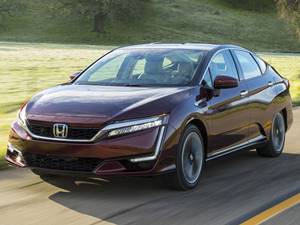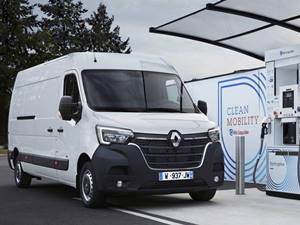Toyota Mirai Hydrogen
Roman Frey 9:34 AM News

The Japanese brand expected to sell between 50 and 100 Mirai in Europe between 2015 and 2016. But even that modest figure would only be possible with the help of the energy companies, as there is hardly any refuelling infrastructure. Unfortunately, the 500-kilometre range is not a deterrent in itself.
In Japan and especially in the USA conditions are clearly more favourable. A Californian, for example, can buy the Mirai for about 46,000 euros and receive a subsidy of up to 14,000 euros if he wants to rent the car for 400 euros a month. In addition, between the cities of San Diego and Sacramento, the Mirai can be filled with hydrogen for free at the nearly 200 gas stations open to the public and there is a 24-hour telephone service in case there is a problem. Finally, in the USA there is an eight-year warranty on hydrogen system components, while Europeans are only entitled to three years.

Toyota believes in the fuel cell and, unlike the first hybrid drive in 1997, this time around it will soon have competition. BMW, for example, must also have access to the central unit of the fuel cell system, within the framework of cooperation with Toyota.
Compared with the Toyota Highlander FCV experimental car, the cost of the Mirai has been reduced by 95%. "But it's a bit like the battle of Don Quixote," says development manager Satochi Ogiso, who then concludes with a smile, "many people think that hydrogen is silly. But many thought the same about the Prius."

The Mirai is powered by a front-mounted electric motor that is not unlike the Prius's engine. It has a maximum power output of 155 horsepower, can accelerate from 0 to 100 kilometers per hour in 9.6 seconds and has a top speed of 178 kilometers per hour.
This front-wheel-drive car, which weighs 1,850 kilograms, is particularly fast in "Power" mode thanks to the maximum torque of 335 Nm that has made a good impression on us.

The electric motor, the batteries and the onboard electronics come from the brand's own hybrids. The high-pressure tanks (which can carry 5 kilograms of hydrogen with their 122.4 liters of volume) can be filled at a service station in five minutes, which should be enough to cover 500 kilometers (the announced autonomy). Problems such as cold starting or evaporation (which occurs when the car is parked for some time without running) have been solved in recent years.
- Power: 153 hp
- Fuel: Hydrogen
- Start-Stop Technology
- Fuel Cell
- Toyota fuel cell system
- Warranty up to 2 years
- Length: 4.67 meters
- 5 seats
- Mixed fuel consumption WLTP hydrogen: 0.9kg /100 km
- Price: From €45,000

The Japanese brand expected to sell between 50 and 100 Mirai in Europe between 2015 and 2016. But even that modest figure would only be possible with the help of the energy companies, as there is hardly any refuelling infrastructure. Unfortunately, the 500-kilometre range is not a deterrent in itself.
In Japan and especially in the USA conditions are clearly more favourable. A Californian, for example, can buy the Mirai for about 46,000 euros and receive a subsidy of up to 14,000 euros if he wants to rent the car for 400 euros a month. In addition, between the cities of San Diego and Sacramento, the Mirai can be filled with hydrogen for free at the nearly 200 gas stations open to the public and there is a 24-hour telephone service in case there is a problem. Finally, in the USA there is an eight-year warranty on hydrogen system components, while Europeans are only entitled to three years.

Toyota believes in the fuel cell and, unlike the first hybrid drive in 1997, this time around it will soon have competition. BMW, for example, must also have access to the central unit of the fuel cell system, within the framework of cooperation with Toyota. Compared with the Toyota Highlander FCV experimental car, the cost of the Mirai has been reduced by 95%. "But it's a bit like the battle of Don Quixote," says development manager Satochi Ogiso, who then concludes with a smile, "many people think that hydrogen is silly. But many thought the same about the Prius."

The Mirai is powered by a front-mounted electric motor that is not unlike the Prius's engine. It has a maximum power output of 155 horsepower, can accelerate from 0 to 100 kilometers per hour in 9.6 seconds and has a top speed of 178 kilometers per hour. This front-wheel-drive car, which weighs 1,850 kilograms, is particularly fast in "Power" mode thanks to the maximum torque of 335 Nm that has made a good impression on us.

The electric motor, the batteries and the onboard electronics come from the brand's own hybrids. The high-pressure tanks (which can carry 5 kilograms of hydrogen with their 122.4 liters of volume) can be filled at a service station in five minutes, which should be enough to cover 500 kilometers (the announced autonomy). Problems such as cold starting or evaporation (which occurs when the car is parked for some time without running) have been solved in recent years.
- Power: 153 hp
- Fuel: Hydrogen
- Start-Stop Technology
- Fuel Cell
- Toyota fuel cell system
- Warranty up to 2 years
- Length: 4.67 meters
- 5 seats
- Mixed fuel consumption WLTP hydrogen: 0.9kg /100 km
- Price: From €45,000




